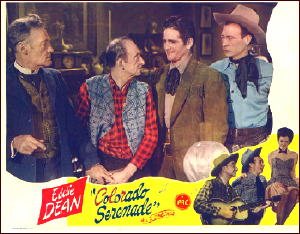September 2011
Monthly Archive
Wed 7 Sep 2011
REVIEWED BY DAN STUMPF:
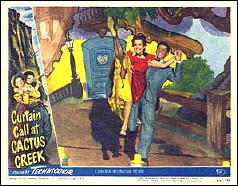
CURTAIN CALL AT CACTUS CREEK. Universal, 1950. Donald O’Connor, Gale Storm, Walter Brennan, Vincent Price, Eve Arden, Chick Chandler, Rex Lease, I. Stanford Jolley. Director: Charles Lamont.
As I have noted before, Universal was best-known for its horror films — not all of them classics — and their comedies tended toward dire efforts with the likes of Francis the Talking Mule. But now and again, quite unexpectedly (perhaps unintentionally) they came out with an off-beat and lightly enjoyable piece like Curtain Call at Cactus Creek, written and directed by the folks who usually worked on Abbott & Costello comedies. This hasn’t aired on TV in a generation, but I found it on DVD recently and fell in love.
Curtain / Creek offers Donald O’Connor as the one-man stage crew of a threadbare theatrical troupe, shooting off amusing stunts and sight gags as he juggles props and struggles for stardom, worshiping ingénue Gale Storm from anear while handling deadly desperadoes and discontented customers with gawky aplomb.
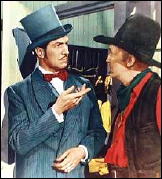
It’s the kind of part Harold Lloyd and Buster Keaton made their own in the silent movies, and O’Connor wears their mantle quite capably, jumping about at the least excuse and generally making the film fun to look at. Gale Storm is also rather nice as the romantic interest, projecting a predatory vitality that has its moments, but the movie really belongs to its supporting players, Eve Arden, Walter Brennan and Vincent Price.
Brennan here plays an aging bank robber who years ago fell in love with a picture of stage sensation Lily Martin (echoing his role in The Westerner a decade earlier) and delighted now to meet her in the impoverished person of Eve Arden.
As the story jumps along, Brennan hides out with the acting troupe and takes an avuncular interest in O’Connor’s struggle to make himself worthy of Gale Storm, softening his (Brennan’s) crusty exterior — another familiar theme of the silent days, and the source of some fun here.
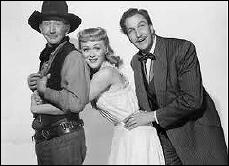
Then there’s Vincent Price, strutting about as the Leading Man, dressed in elaborate-looking but rather tawdry outfits, looking aristocratically down his nose at the world in general (and O’Connor in particular) and dumping spectacularly eloquent abuse on Walter Brennan. It’s the kind of part Price was born for, and he’s consistently funny here, constantly quoting Shakespeare, but usually from the lesser plays — a nice touch that, and one you don’t expect in a Universal comedy.
Chief delight, however, is Eve Arden as the sadder-but-still-arch faded star, ruefully accepting the worship of Brennan’s grimy outlaw and taking the world with that weary-but-game humor that she made her own. Tossing off her reaction to a near-sighted admirer (“That explains a lot!”) or trying to cheer up Donald O’Connor as he faces twenty years in jail with “See you (pause) later,” Arden adds a layer of thoughtfulness to a film that already has plenty of charm.
Tue 6 Sep 2011
WHY I DON’T WATCH TV’S CASTLE
A Rant by Michael Shonk
CASTLE. ABC. Season Premiere: “Rise.” September 19, 2011. Monday at 10e/9c.
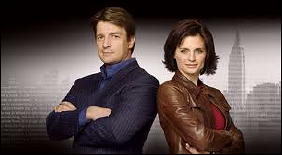
I really want to like Castle. Everyone tells me how wonderful it is, the mysteries, the characters, the actors, the romance, but, sorry, I can’t make it through one episode without throwing something in anger at my TV. And I like my TV.
For example, currently available on YouTube is this clip:
CASTLE-4×01 Sneak peek (Episode 1 Comic Con Preview)
Should the link stop working, the following is a detailed description of what happens:
Visually we open with cuts between black screen and gunshot victim series female lead Kate Beckett (Stana Katic). Beckett is unconscious on a moving hospital gurney. Shots start at extreme close up and pull back shot by shot. We hear the sound of the heart monitor beep despite that there is no machine anywhere to be seen. Finally we hear the sound of flat-lining and fade to black.
BANG! Hospital doors fly open. We see two paramedics racing from one hallway into the next section of the long hallway.They are running with the gurney Beckett is on. Also on the gurney is Beckett’s best friend, Dr. Lanie Parish (Tamala Jones) who is maintaining hand pressure on the bloody wound and ordering Beckett not to die.
Cue violins in soundtrack.
Cut to Beckett. Then Castle (Nathan Fillion) running to keep up. Still moving down the long hallway the camera intercutting between Lanie, her bloody hand and Beckett. Shot of hallway wall and help coming. More of the gurney ride. Help arrives and tells Lanie to let him take over.
“She is my friend, you understand that? She’s my friend.”
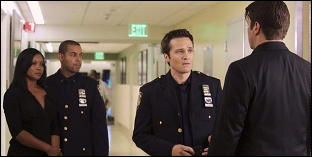
“Then let us save her life.”
Lanie is standing in the hallway when Castle catches up and they watch the gurney continue its journey down the hallway. Laine and Castle look worried. Go to black.
What the writers hope to accomplish with this scene is to make you feel the emotions of Lanie and Castle over the possible death of Beckett, and to do so in an exciting visual way. So what is wrong with this scene? Why is my TV shaking in fear as I look for something to throw?
First, running is not visually exciting unless there is a threat of danger behind it. Becket is not going to die. The only danger is if Lanie falls off the gurney.
Second, the scene is supposed to emotionally effect us. We should share the feelings of the characters. But everything is too over the top, from the soundtrack of the beeps from nowhere and sad TV music to the incredibly awful dialog such as “Then let us save her life.”
Third, no hospital in any Universe would force an emergency patient to travel down a long hallway to get to the doctors. Beckett is a police officer with a gunshot wound and brought to the hospital by an ambulance. Wouldn’t the ambulance park closer to the Emergency Room? Wouldn’t someone have called ahead so emergency personnel would be waiting for the ambulance when it arrived? When every second could mean life or death, they take the scenic route.
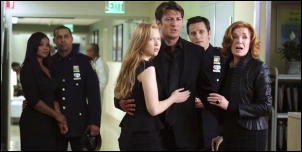
So, how did this melodramatic scene affect me? Well, when I stopped laughing at the Calvary charge down the endless hallway, I became annoyed that the writers held such little respect for the viewers they thought this manipulative scene would be so emotionally moving we would not notice how stupid it is.
Jeopardy is an exciting powerful dramatic device that rarely works on television because TV writers are in denial that everyone knows stars don’t die without media spoilers.
Castle and Beckett are the only two characters on Castle who can’t die or the series is over, This is why jeopardy is usually left to the supporting or guest cast, but who cares about them? Because the nature of the series format, jeopardy can still work but rarely involving death.
While you don’t see it in the clip above, Castle did set up an effective season ending cliffhanger involving jeopardy. The death of supporting character Captain Montgomery left open the possibility new Captain Gates might interfere with Castle tagging along on murder investigations or even worse interfere with his on-again off-again romance with Beckett.
Fans did not worry about Beckett possibly dying, but they did respond to the jeopardy Gates could cause Castle and Beckett’s relationship. Me, the thought of yet another logic defying obstacle to Castle and Beckett having sex is enough to have me whimpering for mercy.
Yes, Castle is only a TV show. You just want to enjoy it, not think. It is just one scene of many. And the series is a comedy mystery where reality is an occasional visitor. But logic is still required. Riding a gurney with a dying woman down an extra long hospital hallway is so stupid it rips me out of the story and rudely reminds me I could be wasting my time more productively with another TV series.
I really want to like Castle I really do, but my brain won’t let me.
Mon 5 Sep 2011
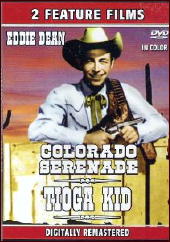
â— COLORADO SERENADE. PRC, 1946. Eddie Dean, Roscoe Ates, David Sharpe, Mary Kenyon, Forrest Taylor, Dennis Moore, Abigail Adams, Warner Richmond, Lee Bennett, Robert McKenzie. Screenplay: Frances Kavanaugh. Director: Robert Emmett Tansey.
â— THE TIOGA KID. PRC, 1948. Eddie Dean, Roscoe Ates, Jennifer Holt, Dennis Moore, Lee Bennett. Screenplay: Ed Earl Repp. Director: Ray Taylor.
Personally, speaking for myself, Eddie Dean is the unlikeliest of B-western heroes that I can think of, although perhaps I’m not thinking hard enough. From a distance he doesn’t have the body build of a cowboy, and in the movies he’s been in that I’ve seen, he’s far more handy with a guitar and a song than he is with a gun. On the other hand, in The Tioga Kid, he has a huge smash-up-the-bunkhouse fight with another guy that busts up the stove, the bunks, the table and several chairs to boot. Very nice!
As far as songs are concerned, there are more in Colorado Serenade than there are in the later movie, four to maybe only three, but the latter makes up for it by adding an equal amount of time in watching the bad guys being chased by the good guys on horses, or is it the other way around? Who can tell.
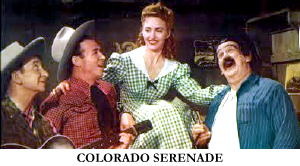
One big difference between the two movies is that the first one is filmed in color, and this I found impressive. Not many B-westerns were filmed in color in 1946. (Were there?) It also has a story line that’s actually interesting, one which has Eddie and his pal Soapy (Roscoe Ates) giving a helping hand to a circuit judge (Forrest Taylor) being sent to clean up one of those towns in the west being run by a gang of outlaws.
But wait. There’s more. Unknown to the judge, always willing to give a bad man the benefit of the doubt if he decides to go straight, is that the head of the gang he’s after is his son, who kidnapped by a really bad guy when he was just a boy. In fact neither father nor son knows the relationship between them, which gives the movie a deeper meaning than do most films of this caliber.
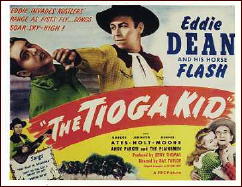
No such luck when it comes to The Tioga Kid, which is about as dull as it could be, even though Eddie Dean plays two characters in this one, two brothers, one good, one bad. This is a fact unknown to either one of them, but since the two are all but identical, there are some who suspect they’re related. But while the resemblance really is uncanny, you can easily tell which one is the Tioga Kid. He’s the one who dresses in black with a cigarette dangling from the left side of his mouth.
There’s not much more to the story than this. It is a remake, although never mentioned, of an earlier Eddie Dean film, Driftin’ River (PRC, 1946), written by the same Frances Kavanaugh who was responsible for Serenade. In the latter several scenes are taken – not remade, but simply taken from the former and inserted into this one (see below). I wonder how it happened that pulp western writer Ed Earl Repp got credit for the screenplay. From the description of Driftin’ River, he added very little. (One source says about 15 minutes’ worth.)
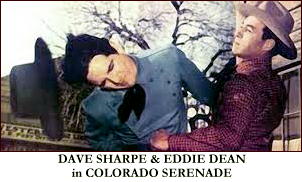
Amusingly (sort of), there is a scene in Tioga in which a grizzled old ranchhand (William Fawcett, I believe) appears briefly perched on a fence as the ranch lady tries to break a bronco, then disappears mid-scene, never to show up again. Tioga, as it turns out, was either the last or next to last movie produced by PRC. They’d reached the bottom of the barrel, the end of the line, and it shows.
But getting back to Colorado Serenade briefly, I see I’ve failed to mention famed stuntman David Sharpe. He has a rare starring role in this one, a mysterious young cowboy with a big handsome smile. No one in the movie seems to know how he gets around or which side of the fence he’s on, but I think somebody missed a bet. Eddie Dean was OK, but charisma, he was a little short of. It’s only a thought in passing, but I wonder how David Sharpe would have fared if he’d been the star of long line of B-western movies too. Says IMDB, he “probably holds the honor of being in more films (albeit, often uncredited as a stuntman) than any other person in Hollywood history.†Four or five thousand, can it be?
« Previous Page











